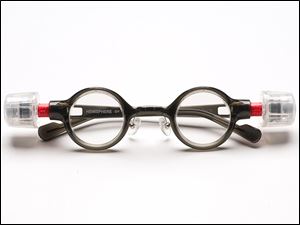
TECHNOLOGY
3 high-tech glasses for sale won’t give you Google-y eyes
Specs serve a more traditional role: Improving vision
7/13/2013
The Adlens Hemisphere glasses.
If someone mentions the phrase “high-tech glasses,” you probably assume they’re talking about Google Glass, the smart phone-on-a-headband that Google hopes to offer for sale next year.
The truth is, though, that 2013 has been the Year of the High-Tech Glasses in other, quieter ways. At least three new eyeglass technologies have arrived. They’re not intended to bring the Internet to your eyeball. They have a more traditional goal: Improving your vision.
Here’s a look at three:
ADLENS VARIABLE FOCUS GLASSES: Yes, it’s an unfortunate name; Adlens glasses may be the one place in today’s world where you won’t encounter advertising.
“Ad,” in this case, is short for “adjustable” — these are variable-focus glasses. The lenses of the Lennon and Hemispheres styles ($80 and $100; adlens.com) are filled with liquid, and cylindrical plastic knobs protrude from the sides. By turning the knobs, you precisely adjust the liquid pressure on a curved membrane inside the lens, affecting its power (from — 4.5 to +3.5 diopters). They can handle even severe nearsightedness or farsightedness.
There are distinct advantages to variable-focus glasses like these.
First, you can tweak the lenses independently for each eye.
Second, you can adjust them for different situations — tired eyes often need more help — or even different people.
Third, you can adjust them yourself without requiring an eye doctor or a prescription. That’s a big deal in poor countries like Rwanda, where, Adlens says, there are 10 million people but only 14 optometrists.
The Lennon and Hemisphere styles look goofy because the lenses are perfect circles, like half dollars, which isn’t a design that will suit many faces. (They’re available in a wide range of frame colors and lens tints.)
Furthermore, the adjustment knobs are big, ribbed, and absurd looking, sticking out beyond the frames. Once you’ve dialed up the perfect focus, you can snap off the knobs, but then the glasses are no longer adjustable. You’ve locked in that “prescription” forever.
The third Adlens style, Emergensee ($40), is slightly more conventional-looking. Its adjustment knobs are much smaller and less conspicuous. They stay on, so you can always adjust the focus.
O2AMP COLOR-ASSISTING GLASSES: O2Amp makes tinted-lens glasses for the medical profession. According to the company, these give doctors a “clearer view of veins and vasculature, bruising, cyanosis, pallor, rashes, erythema, and other variations in blood O2 level, and concentration,” especially in bright light.
The purplish pair, the Oxy-Iso ($302), has an unintended side effect, the Web site says: They “may cure red-green colorblindness.”
I just about hit the ceiling when I read that. Like about 8 percent of the male population, I’m colorblind; I have severe red-green colorblindness. Unfortunately, the Oxy-Iso glasses did nothing for me.
“We do have about one or two in 20 that don’t get any benefit, and it’s due to their colorblindness being too severe,” the inventor wrote to me. “What our technology does is amplify weak red-green sensitivity. But if there’s basically no red-green sensitivity at all, then there’s nothing to amplify.”
But if you’re red-green colorblind, and it’s worth $300 to be able to distinguish colors for the first time, you should try them. You get your money back if they don’t help you.
GLASSES.COM 3-D VIRTUAL TRY-ON APP: Nothing is more design-dependent, fit-dependent, or person-dependent than glasses. And few things make a bigger difference to your looks. That’s why most people buy glasses at a store, trying on pair after pair in a mirror, accompanied by trusted friends or family.
The online store Glasses.com has created some exceptionally slick, polished, useful software to address this problem. Its free iPad app creates a 3-D, photo-perfect model of your head — and then lets you “try on” thousands of different colors and styles of glasses and sunglasses. (Android and iPhone apps are coming.)
Hold your iPad flat against a bathroom mirror. The app’s voice prompts you to turn your virtual head slowly from fully left to fully right; in a second step, you hold the iPad facing the mirror against your chin while it measures your face. You see it create a wire-mesh 3-D model, Terminator-style, then boom: There’s a perfect, photographic, 3-D model of your head.
Now the fun begins. You can “try on” any of 2,000 glasses designs in the company’s catalog. They’re well organized by style, color, price, brand, and so on.
Using your fingers, you can turn your head 90 degrees left or right. You can view four copies of your head on one screen, turning them in sync, to make it easier to compare glasses.
Glasses.com is not, ahem, a purveyor of cheap eyeware. Sunglasses range from $50 to more than $450.
Fortunately, Glasses.com offers an equally impressive try-at-home program. You can order four pairs at a time, wear them for a week, and return the ones that didn’t make the cut; the company pays all the postage both ways.